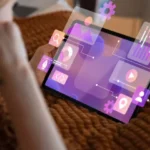We live in a technological age where electrical devices have become ubiquitous, and most humans are constantly exposed to electromagnetic fields (EMFs). Today, with the advancement of electronic devices we tend to use, we should be aware of how EMFs affect our health. EMF meters become useful instruments in helping people detect electromagnetic fields within their residences and assess EMF exposure levels. In this post, we delve into the importance of these gadgets, enumerating the advantages and why every home should at least think about having one.
What Are EMFs?
Electromagnetic fields (EMFs) are invisible, dangerous long wavelengths with intermittent communication. Threats come in the form of energy waves produced by electrical power and wireless communications. Such fields are created in nature and can also be produced by electronic appliances. Some common sources include cell phones, Wi-Fi routers, microwaves, and televisions around your house. While generally deemed to be safe, long-term exposure to some EMFs can have detrimental health effects. Peace of mind with EMF meters ensure safe exposure, protecting our living sustainability.
Types of EMF Meters
EMF meters come in two main types: single-axis and tri-axis. Single-axis meters measure electromagnetic fields in one direction, requiring multiple readings for accurate data. In contrast, tri-axis meters measure in three directions simultaneously, providing more comprehensive data with fewer steps. While both have their advantages, tri-axis meters are generally preferred for their ease of use and efficiency, making them a more convenient option for quick and thorough EMF detection.
Why You Should Buy An EMF Meter
There are several benefits of owning an EMF meter. For one, it enables people to recognize potential heavy EMF sources within their households. These reports can help homeowners reduce their exposure by identifying high-EMF areas. Secondly, it helps in deciding where and when the use of electronic gadgets should be allowed. In brief, the EMF meter can put in place safety measures for life so that everyone will lead a healthy life without any consequences of health issues due to high emanation from such devices.
Identifying EMF Hotspots
EMF hotspots are places that emit a large amount of EMR. Household hotspots can often times be the immediate vicinity of a Wi-Fi router, microwaves or electric panels. This is why people use an EMF meter so they can find these spots out and put something which might limit the exposure. A few simple changes, such as relocation of electronic devices or using shielding material can drastically reduce the EMF levels in identified hot spots.
Reducing EMF Exposure
Together, those units form the basis of a strategy to identify and cut back on hot spots. So what are some of the ways that you can do this? Instead, it is considerably more useful to avoid high EMF sources from the start. Avoiding technology, especially near bedtime, will help you decrease your exposure. Second, hardwiring also just plain cuts down on how many EMF-emitting devices you have in your home. Third, purchasing EMF shielding products to further reduce exposure, thus giving you a safe place to live.
Effects of EMF Exposure on Health
Evidence on the health consequences of EMF exposure is still being sought. Certain researches speculate about the potential long-term health impacts of high-level exposures to EMF. Although evidence is still not clear, some of the possible symptoms may include headaches, fatigue, and sleep disorders. While incomplete answers are far from definitive, steps can be taken to reduce exposure, and thus protect your home.
Choosing the Right EMF Meter
There are several considerations you need to make when choosing the right EMF meter. Identify the nature of EMF emissions to be monitored. There are detectors that pay attention to radiofrequency fields, and others that focus on magnetic fields. The second would be the sensitivity and frequency range of the meter. This is to be able to get better readings across the variety of devices. As a final consideration, evaluate ease of use and whether the device is easily portable to determine if it caters to individual needs.
Conclusion
An EMF meter is a useful tool for maintaining a healthier home environment. It measures electromagnetic field (EMF) exposure, helping you identify high-risk areas where EMF levels are elevated. By pinpointing these hotspots, you can adjust appliance placement, limit exposure, and make more informed decisions about your home setup. Whether it’s your bedroom or office space, managing EMF exposure proactively can improve your overall well-being, reduce potential health risks, and provide peace of mind in creating a safer living space for you and your family.










